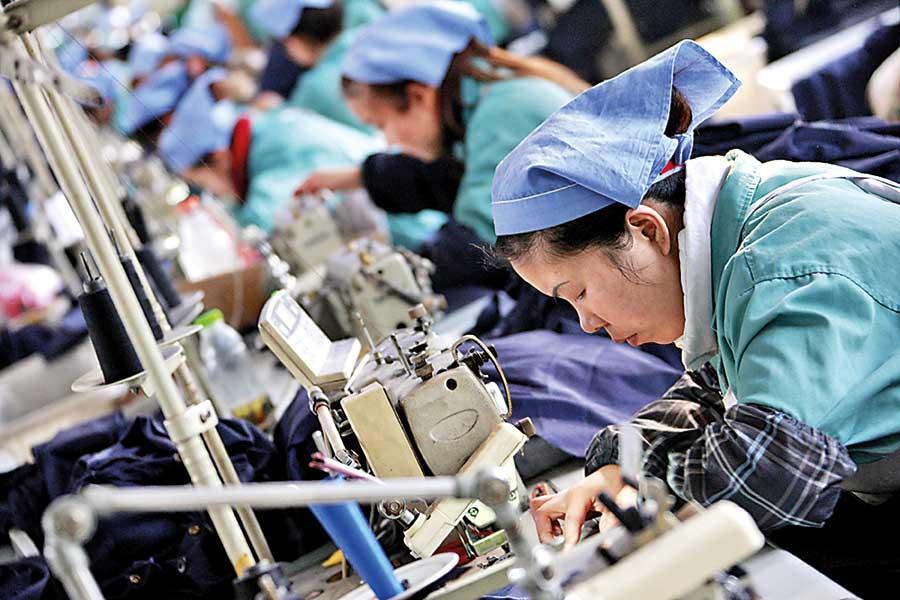
One should be cautious about making doomsday predictions, and should not forget the resilience, determination and energy which made it possible to lift millions of Chinese out of poverty in two decades
While social media is packed with doomsday predictions of the American economy (Europe isn’t doing any better, either), there is an equal or greater number of videos forecasting the

decline of China, an economic juggernaut that looked set to overtake the US before the pandemic.
When navigating across this sea of negative analyses of China, from American, European or Indian sources, one must bear in mind that there are those who either dislike or fear China enough to wish it economic doom.
Sabre rattling
True enough, the Chinese leadership (which is essentially President Xi Jinping, who now looks set to overtake both Mao Tsedong and Deng Xiaoping as the longest serving Chinese leader, with more powers vested in himself), has given the rest of the world (except its close allies Russia, North Korea, Pakistan and Myanmar) enough reason for that. Chinese foreign policy, which includes increasingly loud sabre rattling over Taiwan, disputes with South East Asian neighbours, luring countries into debt traps and espionage in vital sectors as artificial intelligence, can hardly be described as benign.
For this writing, I have relied by data and statistics from Indian and American sources. Shekhar Gupta, editor of the online newspaper The Print and usually a very reliable and articulate source on international geo-political issues, is one. While admitting that he’s not a financial expert, he has researched widely and his main source on this matter is Ruchir Sharma, a respected writer for the Financial Times.
The other sources are American. Even if one assumes a certain bias given their national interests, I feel the figures given are reliable, certainly more so than what China gives us officially as indicators of economic performance.
These facts are beyond dispute. China’s economy grew so fast over the past two decades that, until very recently, it accounted for 18% of global GDP. In 2020, China’s GDP was equal to 76% American GDP, and many expected China to overtake the US soon. But the pandemic, and President Joe Biden’s savvy economic policies, has changed that. Right now, the ratio is down to 65% of the American figure.
Also, China’s share of global GDP is down to just over 17%, again because the US economy under President Biden has shown some progress. The global economy is worth $105 trillion, of which $45 trillion is represented by the US.
Debt to GDP
China’s debt to GDP ratio is 300%. To fuel growth, they will have to keep borrowing and investing. But if this pattern is kept up now, China’s debt to GDP ratio could go up to 400-500% in another five years. Shekhar Gupta puts China’s current growth rate at 2.5%. To double per capita incomes in 25 years, any economy needs to maintain growth rates of above 3%. China’s economic crisis can be described as too much investment, too much debt and, paradoxical as it may seem, too little growth.
China is entangled in a burgeoning real estate crisis. Just how big this is, or if it will cause the Chinese economy to crash, is hard to say, but there is no doubt it is messy and has put Chinese banks, too, in trouble. Real estate has been a key factor in China’s economic boom, in which all local governments have invested heavily. Reports say that five of China’s biggest real estate companies have defaulted. We’ll get back to this later.
Declining industrial output and an ageing population are other major problems. China’s anti-Covid restrictions were so severe that many investors moved their factories out of China. Vietnam and Indonesia have benefitted from this, followed by India and Mexico. Investments have represented 40% of China’s GDP for the past 20 years (In India, it’s 25%) and now stands at 42%. China’s labour costs have gone up by 7%, not attractive to multinational companies looking for cheap labour. As manufacturing accounts for 30% of China’s GDP, (in the US, it’s only 11% of GDP), this is a major issue.
Loss of foreign investments, coupled with the real estate crisis, has put a spanner in China’s economic drive. Another crucial factor is the unpredictability of President Xi Jinping who doesn’t hesitate to destroy people seen as a danger to him swiftly. The way he dealt with billionaire technocrat Jack Ma is an example, and this has scared investors. His sabre-rattling over Taiwan too, doesn’t help investor confidence, though it’s very unlikely China will invade Taiwan in 2025 as many have forecast. We’ll look into that in a later column.
Consumption rate
By 2040, an estimated 412 million Chinese would be over 60. They are now spending less and saving for retirement. The global norm for consumption is three US dollars of consumption for each dollar of investment. China’s consumption rate was healthy during the boom years, but now it’s down to 1.3 US dollars for each dollar of investment.
Adding to this problem is another paradoxical one. During the boom years, Beijing set a goal of quality education for the new generation. The result is a mass of highly qualified twenty something graduates without enough jobs. They are reluctant to take up the factory jobs that were the lot of their parents.
Now let’s look at what happened to the real estate boom. Real estate is a minefield on which complacent economies cripple themselves. It was responsible for triggering off Japan’s decline two decades ago, and the end of the South East Asian economic dream in the 1990s.
As China set a goal of becoming the world’s number one economy, a 5% growth rate was set. To reach this target, local governments raised money by auctioning off state land. Tens of thousands of apartments were pre-sold to customers and this is how construction companies financed their projects. But, with problems such as the pandemic, more unemployment, an ageing population focusing on saving more than spending, and reduced incomes, many huge corporations got into trouble over the last few years, and the five biggest have default. Two million unfinished apartments can be seen in many parts of China.
To solve the real estate crisis, China introduced the ‘three red lines’ rule for construction companies. The three rules are:
- Liability can’t be more than 70% of assets.
- Debt to equity ratio has to be below 100%, which means you can’t borrow more than your equity.
- Cash to short term to debt has to be 100%, meaning cash in the bank should be more than your short term debt.
Meeting all three criteria, one could borrow 15% more, but few managed.
Doomsday predictions
Is the Chinese economy doomed as some forecast? It is certainly in some trouble, but one should be cautious about making doomsday predictions, and should not forget the resilience, determination and energy which made it possible to lift millions of Chinese out of poverty in two decades and made China the chief competitor of the US as the world’s most powerful economy. But it will have to avoid getting into an arms race with the US, forget about invading Taiwan at least for now, and be less paranoid and more humane when dealing with internal enemies, real or imagined, for any meaningful recovery.

 decline of China, an economic juggernaut that looked set to overtake the US before the pandemic.
decline of China, an economic juggernaut that looked set to overtake the US before the pandemic.